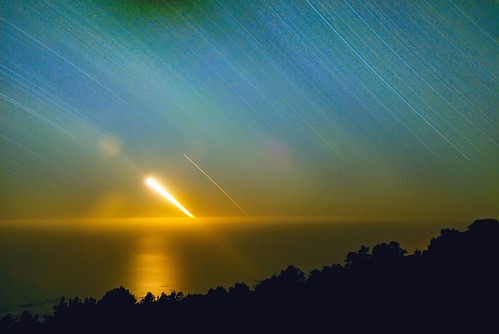On our Sea Ranch vacation we had a number of clear nights without fog. I took advantage of these nights to photograph the night sky over the Pacific. Each clear night until we moved to another house I set up a long time exposure. We moved because of a scorpion in the house, a broken dishwasher, and raccoons in the trash: another story. But the next house was in a Sea Ranch suburb without the same unbroken view of the night sky.
My modus operandi on clear nights was to set the camera up just below the hot tub. I used my timer to set a delay of some hours, and used the camera’s Bulb setting to open the shutter for a number of hours. After the hot tub, Phyllis and I went to bed and I got up and examined my results in the morning. I used an AC power supply plugged into an extension cord, because even one of these exposures takes more juice than my D200 has in a battery.
This is a 6,554 second exposure, or close to two hours, starting at about 12:30AM and ending around 2:30AM. The bright, comet-like light is the setting moon going down into the ocean while stars wheel round above. You can see lens artifacts in the image caused by the comparative brightness of the setting moon during this long time exposure.
When I post-processed this image, I intentionally left noise in the sky. It seems to me a better effect than making the star trails seem too smooth. After all, noise is the digital era’s version of grain: like grain it can be used for aesthetic purposes.
Related site: Digital Night by Harold Davis.
[16mm, 24mm in 35mm equivalent terms, 6,554 seconds at f/16 and ISO 100, tripod mounted.]

Pingback: Photoblog 2.0: » Photoblog 2.0 Archive: » Barn at Sea Ranch
Pingback: Photoblog 2.0: » Photoblog 2.0 Archive: » Boys in the Tub
Pingback: Photoblog 2.0: » Photoblog 2.0 Archive: » Using the Exposure Equation
Pingback: Photoblog 2.0: » Photoblog 2.0 Archive: » Star Trails
LABRE
12 Apr 2008This is so beautiful. Would you allow me to use this picture as a background for a hymn Power Point for our church?